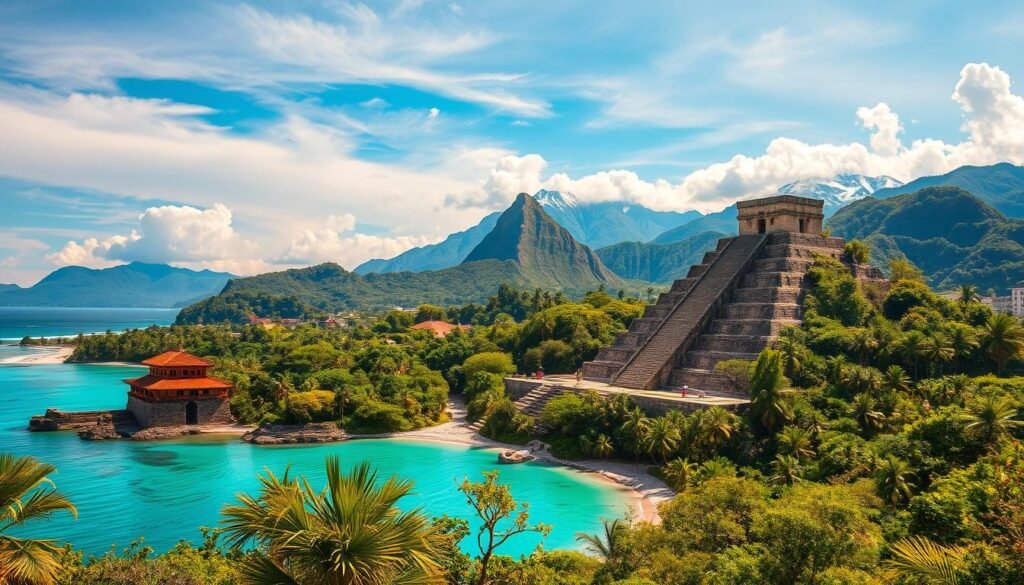Did you know this country holds 35 UNESCO sites and spans snowy peaks, lush jungles, and three distinct coasts? That range makes choosing where to go the hardest part of any trip.
I write from the road and I balance big-name city stops with quieter towns. I call out what makes each spot shine: culture, food, outdoor adventure, and easy day trips that fit a real travel pace.
Expect clear tips on when to chase beaches, where to see whales (December through March), and how cenotes and ancient ruins like Chichén Itzá shape a perfect itinerary.
My aim is simple: help you picture each city and place, then plan a flexible trip that matches how you like to travel. Use this as a practical starting point for the kind of days you want on the road.
Key Takeaways
- I mix famous destinations with hidden gems for variety and depth.
- Season matters: whale season, beach weather, and festival timing guide choices.
- Short day trips can add big rewards without overpacking your schedule.
- Cenotes, UNESCO ruins, and street art highlight regional beauty.
- I focus on practical tips that help you plan a smooth, inspiring trip.
How I Choose the Best Time to Go: Seasons, Weather, and Whale Watching
Timing a trip here means juggling sun, storms, and seasonal marine life. I favor the November–April window for clear skies and warm sand, with December through March shining for Pacific Coast whale sightings.
When I go
November–April offers the most reliable beach days and festival energy. If you travel June–October, I explain how to plan around hurricane season and why some northern destinations still work well then.
Wildlife windows
I time wildlife by month: humpback whales peak on the pacific coast in mid-winter, while whale sharks gather around Holbox and Isla Mujeres from June to September. Early mornings often give the calmest water and the best light for wildlife viewing.
- Quick picks: November–April for dry weather; December–March for whale watching.
- Plan around hurricane risks June–October; pick inland or northern routes for summer reliability.
- Have backups like museums, food tours, or cenote dips for a rainy beach day.
My simple stacking trick: start in a city, add a coast, then finish inland. That balances weather, time, and what you want most—beaches, wildlife, festivals, or budget.
Best places to visit in Mexico
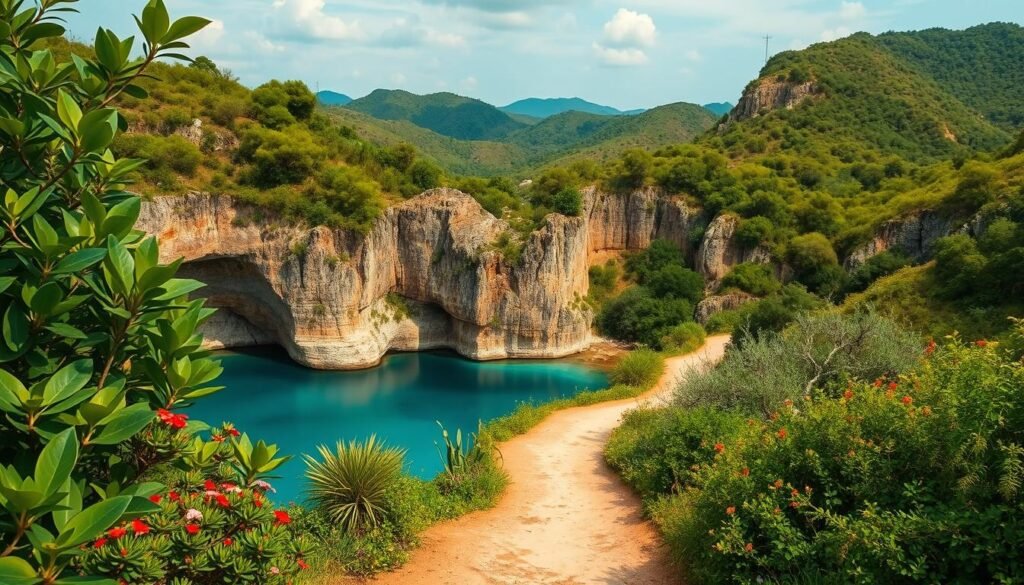
I’ve pared years of travel into a short list of cities, coastal towns, ancient sites, and off-grid finds. This is my lightning-round guide for anyone planning a city + beach combo trip.You can learn more about best-time-to-visit-switzerland
My quick-hit favorites across cities, beaches, ancient ruins, and hidden gems
I start with the Yucatán Peninsula for Caribbean sand and Maya ruins like Chichén Itzá and Uxmal. Then I pair Mexico City for world-class culture—note Frida Kahlo’s Casa Azul needs advance booking.
On the Pacific coast I favor Puerto Vallarta for its food and December–March whale watching. For UNESCO charm, Puebla and San Miguel de Allende deliver architecture and cuisine that reward slow walks.
- City + day trip: Mexico City paired with Teotihuacán or Coyoacán markets.
- Ancient sites: Arrive early to beat crowds at major ruins.
- Beach picks: Snorkel-friendly waters or calm bays for lazy afternoons.
- Hidden gems: Small towns with markets and artisans for a relaxed pace.
Use this short rundown to shortlist destinations and map a trip that matches how you like to travel. I keep this list tight so you can plan faster and spend more time enjoying each place.
Yucatán Peninsula Icons I Love: Cenotes, Caribbean Beaches, and Ancient Ruins
Cenotes, turquoise waters, and ancient stone fronts sketch the Yucatán’s most magnetic days. I base myself in either Cancún or Playa del Carmen for quick beach days, easy day trips, and a lively night scene a short ride away.You can learn more about best-time-to-visit-thailand
Tulum blends sea-facing ruins, relaxed yoga vibes, and dreamy beach clubs. I split mornings between the ruins and an afternoon cenote swim for a perfect balance of history and chill.
Cancún and Playa del Carmen: Beach days, day trips, and nightlife
I use Cancún for fast airport access and Playa del Carmen for a more walkable city feel. The colectivo along Highway 307 makes hopping between those hubs easy for any short trip.
Tulum and Chichén Itzá
For Chichén Itzá I book a guided tour so I get the history and beat the crowds. Arriving early changes everything — cooler light, fewer people, clearer photos at this World Heritage site.
Valladolid and Isla Mujeres
Valladolid is a pastel-lined town with a nightly light show at San Bernardino and nearby cenotes perfect for a refreshing dip. My relaxed day runs the convent, a cenote stop, and a quick food market lunch.
Isla Mujeres is my go-to for laid-back beach time and snorkeling calm waters. I catch the ferry, time a Playa Norte sunset, and leave enough room for a short seafood meal before heading back.
- Tour vs DIY: I choose guided tours for major ruins; I DIY smaller cenotes and nearby beaches.
- Logistics: Ferries, colectivos, and short drives let you cover a lot without stress.
- Mini-itinerary: Day 1—base and beach; Day 2—Tulum + cenote; Day 3—Chichén Itzá and Valladolid loop.
Isla Holbox: Bioluminescence, Flamingos, and That Laid-Back Island Glow
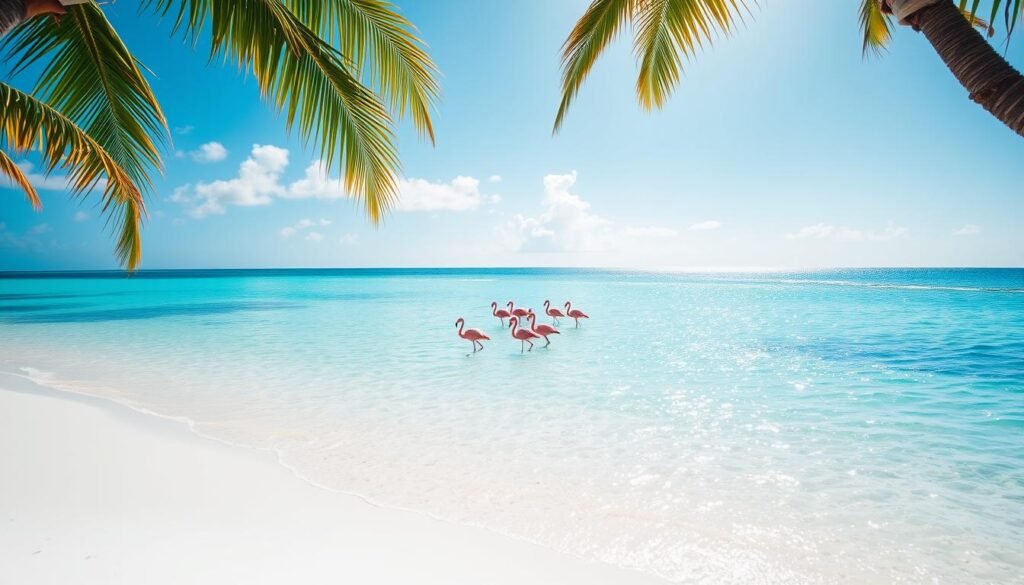
Holbox feels like a slow postcard: sandy streets, bold murals, and evenings that glow along the shore. The town is traffic-free, so I walk or hop a golf cart and let the island set the pace.
Best time for bioluminescence and ethical whale shark tours
When I target bioluminescence is on warm, moonless nights between late spring and early fall. I time my nights near the new moon so the plankton show reads bright against dark waters.
Whale shark season runs June–September. I book a small-group tour that follows no-feed rules and limits boat numbers. That keeps encounters calm and safer for the animals.
- I map a dreamy day: beach strolls at dawn, kayaking mangroves, then a cooling dip at the Yalahau spring-fed lagoon.
- For flamingos, I look toward Punta Mosquito at low tide and mind the tide lines on my walk.
- If I’m short on time, a short night tour can hit bioluminescence efficiently—ask operators about group size and lighting rules.
“Keep it gentle: no feeding, no bright lights, and pack out what you bring in.”
I usually stay 2–3 days to sync with slow days and one clear night for the glow. For more on logistics and things I do on Holbox, see this Isla Holbox guide.
Bacalar’s Lagoon of Seven Colors: Kayaks, Sunrise Cruises, and Slow Days
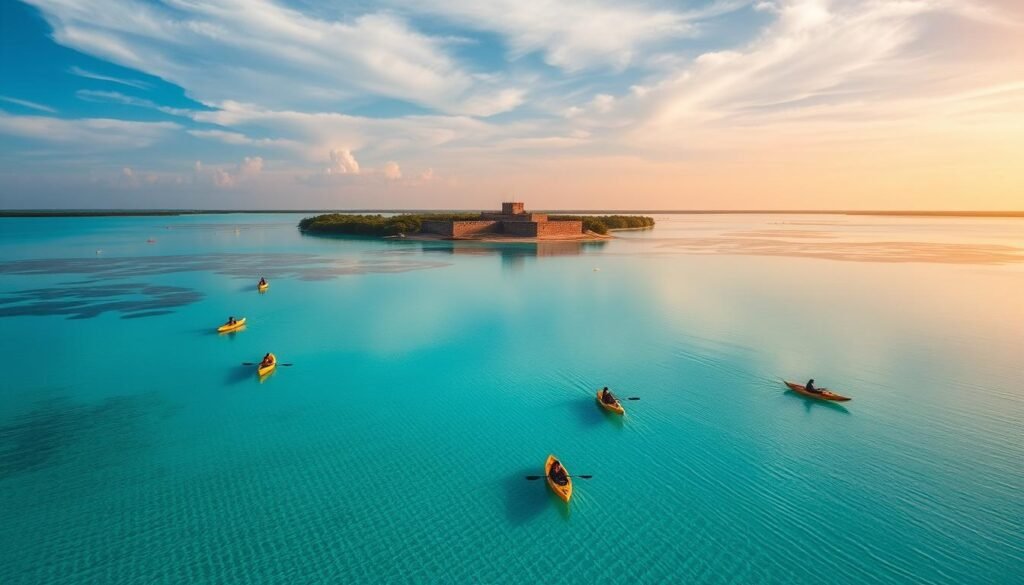
I go to Bacalar when I want a day with a kayak, a hammock, and long views of aqua gradients. Sunrise kayak tours let me glide over glassy water and watch the colors shift from teal to deep navy.
The lagoon’s layers change because cenote-fed springs meet shallow sand bars. Boat trips show the best gradients, and many bars and restaurants have hammocks and docks that drop right into the lagoon pools.You can learn more about best-caribbean-islands-to-visit
I usually stay at a small lakeside inn. That way I hit the calm, early hours for photos and smooth paddling. If you come from Tulum, a half-day trip works well—leave early and return before the busiest afternoon hours.
- I map a perfect slow day: sunrise kayak, lazy swims, then hammock time at a waterfront bar.
- Simple boat itinerary: north channel, cenote inlet, and the color-gradient docks—no rush, just steady stops.
- Packing tips: reef-safe sunscreen, water shoes, and a light dry bag for cameras.
“Choose calm mornings for paddles and save the afternoon for a quiet lunch with a ladder into the lagoon.”
For a real escape in this southern corner of the state, plan 2–3 days. That gives time for slow swims, nearby cenote-fed inlets that feel like private pools, and low-key meals at small town lunch spots with steps straight into the water.
Celestún’s Wild Side: Mangroves, Biosphere Boat Tours, and Pink Flamingos
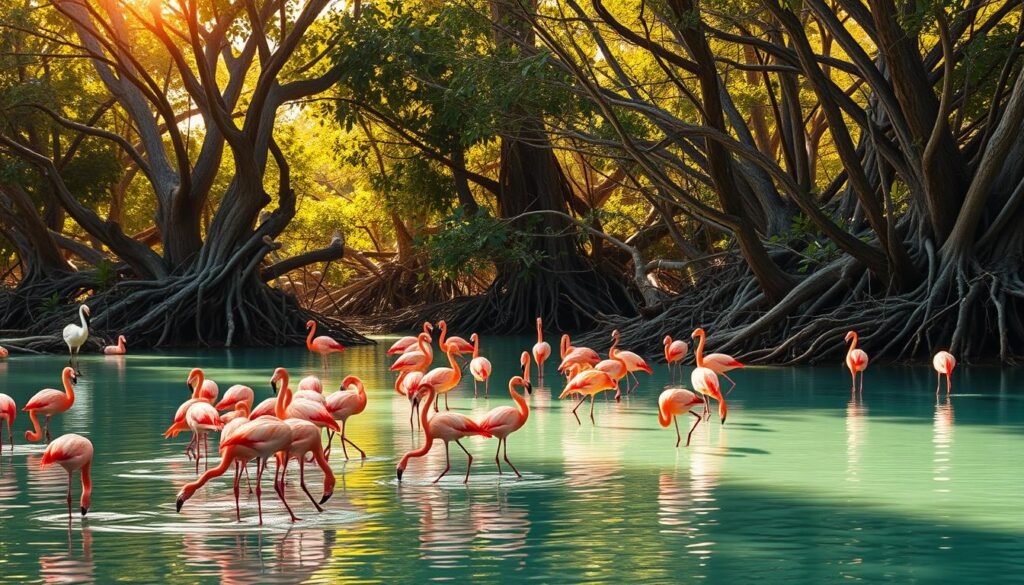
Celestún draws me with pink flocks, shaded mangrove channels, and calm coastal air. I time my boat tour for early morning light so flamingos feed in calm waters and I avoid midday heat.
I drift through narrow mangrove channels with a local captain who knows every turn. We stop at a freshwater spring where I take a quick swim and cool off before a relaxed, beachside seafood lunch in the town.
Practical notes: most tours depart from the small dock near Celestún town. Typical tour length is 3–4 hours; I budget a half day for transport from Mérida and fees. I pick small-group options to keep encounters intimate and educational.
- Respect wildlife: keep distance, no loud noises, and don’t feed birds or crocodiles.
- Pack binoculars, a hat, reef-safe sunscreen, and a light cover for sun on open waters.
- Flamingo numbers rise seasonally; mornings usually give the best visibility.
“A patient, quiet approach gives the best wildlife moments.”
Cozumel: Reef Adventures, Scuba Schools, and Glass-Bottom Boat Fun
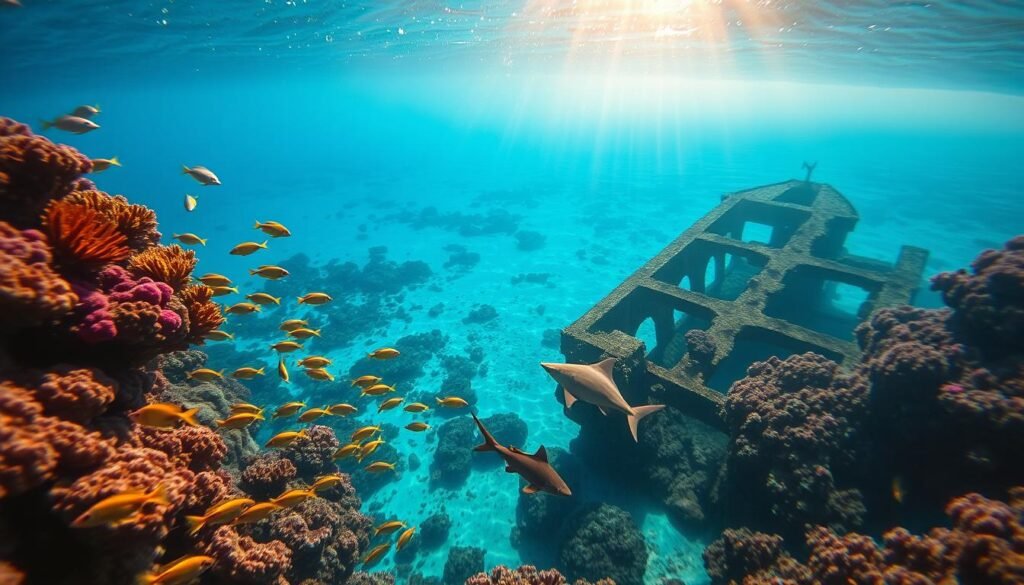
I split Cozumel into one big reef day and one relaxed beach day. On the reef I pick a reputable dive school with small group sizes, recent gear, and instructors who log night dives. That tells me they run safe courses and fun certification dives.You can learn more about best-time-to-visit-iceland
For snorkeling, I favor shallow coral gardens where the waters stay clear and turtles hang nearshore. A short trip from the dock will usually deliver calm visibility and easy entry points.
Glass-bottom boat tours give a quick look at coral without getting wet, while DIY snorkeling lets you linger at turtle spots. If you want both, I often book a glass-bottom boat tour in the morning and save an afternoon for shore snorkeling.
Paradise Beach near downtown is my go-to for a carefree day. It has pools, kayaks, trampolines, and several eateries, so I treat it as a single place for easy relaxation after dives.
- I usually take the ferry from Playa del Carmen for a day run; I fly when time is tight.
- Pack reef-safe sunscreen, a long-sleeve swim shirt, and a dry bag for boats.
- Watch winds: mornings are calmer for dives and better visibility on windy days.
Sample two-day plan: Day 1—cert or fun dives on the reef; Day 2—beach club, taco crawl, and an evening stroll through downtown for a low-key city vibe.
“Choose a dive school with clear safety records and small groups for the best learning and encounters.”
Budget tip: expect certification or two-tank dives to cost more than a glass-bottom tour or beach club day. I plan accordingly so my travel days stay smooth and unhurried.
Mexico City Through My Eyes: World-Class Culture, Street Art, and Food
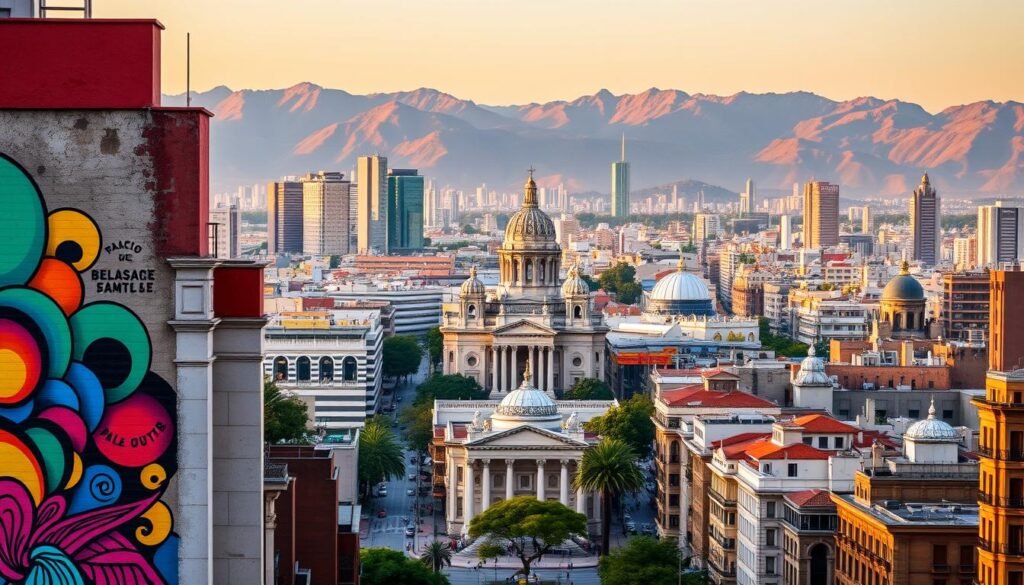
Mexico City feels like a layered novel: each neighborhood opens a new chapter of art, food, and history. I plan my time so I can hit one big museum, a coffee break, and a handful of murals without rushing.
Frida Kahlo’s Casa Azul and booking tips
I book Museo Frida Kahlo (Casa Azul) well in advance—often two to four weeks ahead for peak dates. Reserve a morning slot so you have the rest of the day for museums or a relaxed mercado lunch.
Street art, museums, and Day of the Dead energy
I walk Roma and Condesa for street art, then save an afternoon for the Museo Nacional or modern galleries. Around Día de Muertos the city fills with parades and altars; I time visits to catch both the main route and quieter plaza moments.
How I structure a two-day mini itinerary
- Day 1: Casa Azul morning, Coyoacán market lunch, afternoon museums.
- Day 2: Street art walk, quick museum stop, standout dinner at a classic cantina.
Transport tip: I mix Metro rides, short walks, and rideshares for efficiency. For first-timers, a guided art or history tour adds context and saves time.
“Book ahead, move slowly between corners, and let a coffee break reset your day.”
Oaxaca City: Street Art, Mezcal, and Day of the Dead Magic
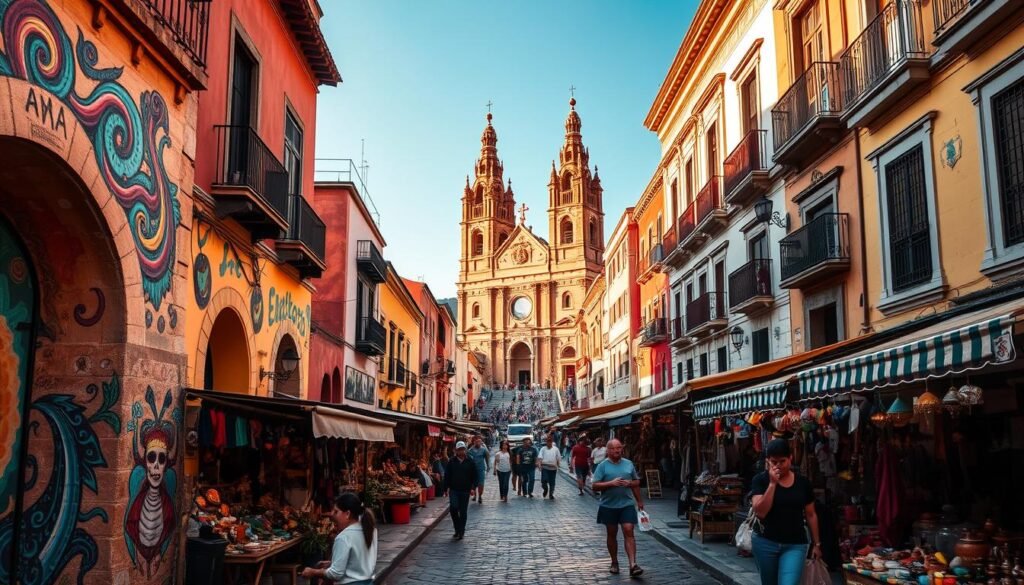
Oaxaca City hums with color, music, and culinary craft at every corner.
Why I plan trips around Guelaguetza and Día de Muertos
I time my visits for Guelaguetza (July) or Día de Muertos (late Oct–early Nov). Big festivals fill weeks, so I book lodging and key events far ahead.
Respectful timing: Santa Cruz Xoxocotlán’s candlelit cemetery vigils are moving. I keep my distance, ask before photographing, and join quietly.
Markets, moles, and artisan villages I never skip
I map a food-lover’s day: morning markets, street eats, a mezcal tasting, and an evening mole dinner that lingers in memory. Oaxaca’s cuisine feels both ancient and inventive.
- I hunt street art between colonial lanes and small studios.
- I day-trip to nearby villages for textiles, pottery, and wood carving.
- For a fast cultural overview, I take a short tour that pairs markets and museums.
The mountains that frame the city make mornings cool and nights crisp. Pack layers for changing temps and plan 3–4 days for the city with an extra day for nearby ruins or villages.
“Move slowly: taste widely, listen to local guides, and leave room for one more market stop.”
San Miguel de Allende: Small-City Charm and UNESCO-Perfect Streets
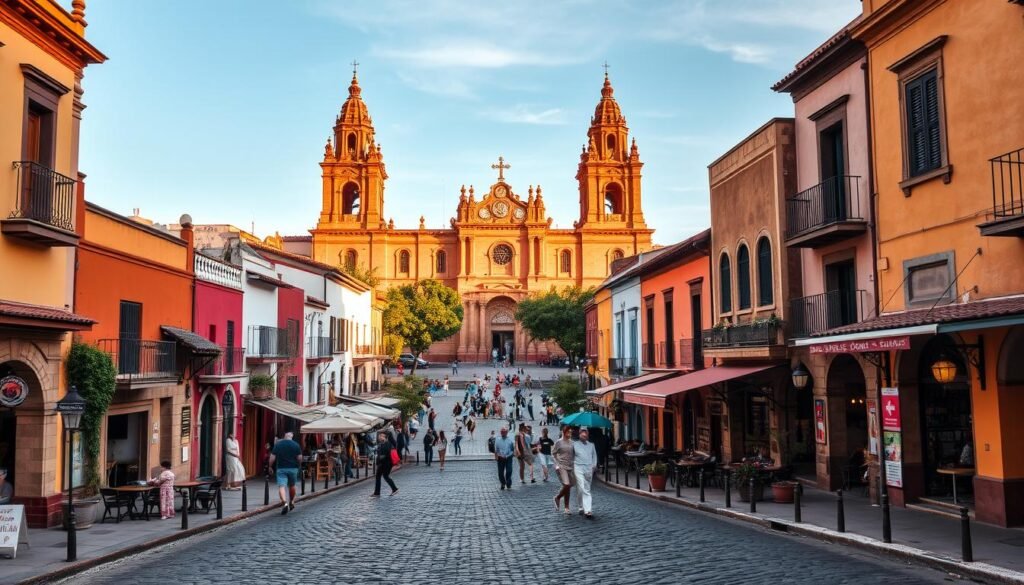
I find San Miguel’s charm in its narrow lanes, rooftop views, and the way musicians gather after dusk. The Parroquia’s pink spires anchor days of wandering and quiet discovery.
Why it feels special: this world heritage city keeps strict preservation rules that protect its colonial colors and cobblestone lanes. That care preserves local character even as an active expat scene grows.
My easy route is simple: morning coffee at a small cafe, a slow loop through artisan studios, and then tucked-away courtyards that reward curiosity. I stop at markets and tiny galleries without rushing.
- I time plazas for golden hour—rooftops and viewpoints glow best just before sunset.
- Pairing idea: add a vineyard or a nearby town for short trips from your base.
- Packing tip: sturdy shoes for cobblestones and a light layer for hilly lanes.
How many days: I plan 2–3 days here. That gives time for markets, a slow museum visit, and an evening with live music.
“One artisan workshop I always return to connects me to the city’s creative culture—hands-on, local, and honest.”
My favorite evening is rooftop views, live music, and a cozy dinner that lets the city’s food and culture settle in. Walk home slowly; San Miguel’s beauty often feels best after dark.
Puebla’s Talavera, Baroque Beauty, and Can’t-Miss Cuisine
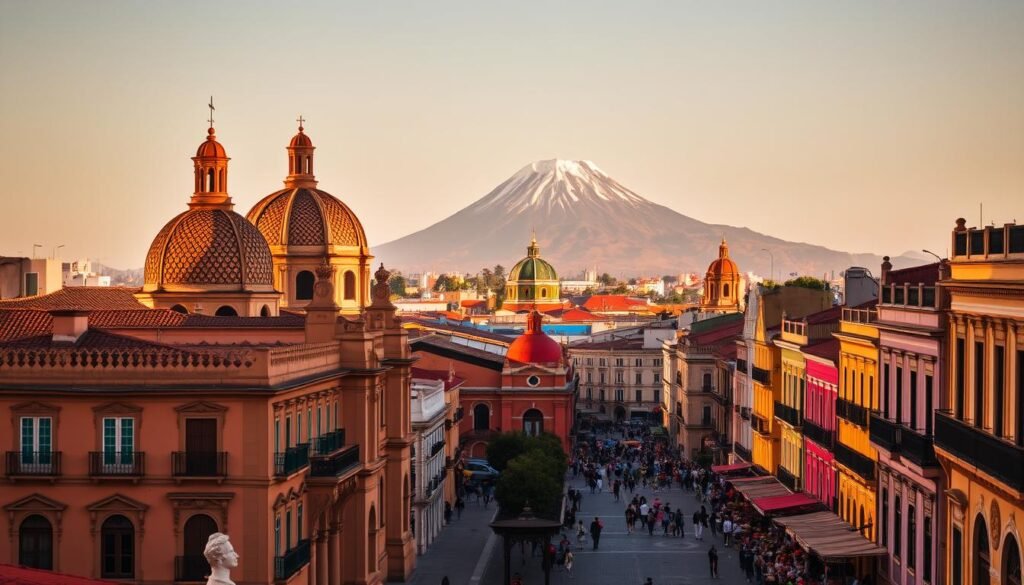
Walking Puebla feels like stepping through a living museum of ceramic tiles and baroque spires. The historic center has over 1,000 colonial buildings and about 70 churches, many sheathed in bright Talavera tiles that catch the light just right.
Chiles en nogada, mole poblano, and modern museums
Food here is a reason people plan a trip. I map a single day that starts with street snacks, moves to a mole poblano lunch, and leaves space for chiles en nogada when they’re in season (late summer to early autumn).
I point my camera at Talavera-lined streets and church facades, but I shoot respectfully—no flash inside chapels and ask before photographing people.
- I fit Cholula’s ancient pyramid and lively town into a half-day or full-day loop from Puebla.
- A guided walking tour ties architecture, local legends, and sampling stops into one smooth route.
- Two modern museums I like balance the historic strolls and give a fresh view of regional culture.
| What I do | Why it works | Quick tip |
|---|---|---|
| Taste mole poblano | Signature regional sauce, rich and layered | Order with rice and warm tortillas |
| Photograph Talavera facades | Colorful patterns and baroque detail | Use a wide lens, respect interiors |
| Cholula side trip | Huge pyramid and town vibe | Climb the church for sunset views |
I usually spend 1–2 days in Puebla as part of a central Mexico loop. For shopping, I pick small Talavera pieces that pack easily—plates, small tiles, or a painted mug make good souvenirs.
“Puebla mixes vivid tiles, layered flavors, and quiet plazas—leave room for a slow café break and a long look.”
Morelia and Lago de Pátzcuaro: Pink Stone, Traditions, and Misty Lakes
I follow the region’s small rituals: Sunday markets, copper workshops, and mist lifting off the lake at dawn.
Morelia’s UNESCO center is all pink stone, with Renaissance, Baroque, and Neoclassical façades that glow at sunset. I map a short city day around plazas, the aqueduct, and a museum stop before a relaxed dinner.
Sunday markets, artisan copper, and Day of the Dead roots
From Morelia I take an easy trip to Lago de Pátzcuaro and Janitzio Island to feel lake life and misty mornings. Santa Clara del Cobre is close; I watch artisans hammer copper and often buy a handmade piece as a keepsake.
The region’s Sunday markets reset the rhythm of each town. I taste Michoacán food—tamales and atoles—and learn local names for ingredients that make each dish distinctive.
- I add a short waterfall or forest walk in the surrounding mountains for fresh air.
- Respectful visits during Day of the Dead reveal deep cultural roots—keep your visits quiet and guided if possible.
- Logistics: Morelia is a useful base; lakeside towns are reachable by a one-hour drive so you won’t lose half a day.
“Plan 2–3 days for this state so you have time for cobbled streets, lakeside mist, and artisan workshops.”
Pacific Coast Favorite: Puerto Vallarta’s Beaches, Malecón, and Whale Tales
Puerto Vallarta mixes golden sand, cobblestone lanes, and an electric evening scene that keeps me coming back. I start with a slow Malecón stroll, watch street art, then slip into a quiet cove for an afternoon swim.
Timing matters: I aim for December through March for the best chance of a whale sighting and calm water on the pacific coast. I book small-group whale tours that follow wildlife rules and limit boat numbers.
I love the yacht trip to Yelapa Falls—waterfalls, snorkeling in Bahía de Banderas, and a festive beachside lunch. For quieter time, I pick lesser-known coves; for lively hours, I head to beach clubs and the Malecón after sunset.
- I map my day: boardwalk, beach, then a sunset over the bay.
- Easy food crawl: seafood stands, ceviche, and a seaside cocktail.
- Combine the city with a short side trip for coastal scenery.
“Book small tours, bring reef-safe sunscreen, and leave room for a slow sunset.”
Baja and the North: Cabo San Lucas Arch, Isla Espíritu Santo, and Copper Canyon Thrills
Cabo’s arch, desert ATVs, and winter whale magic
Baja California stretches about 1039 miles along the Transpeninsular Highway, a classic road route for coastal scenery and desert stops.
I pause at the dramatic Cabo Arch, then split my day between a calm beach hour and an ATV run through nearby canyons. Winter is my pick for whale sightings — calm seas and reliable sightings make that time special.
Isla Espíritu Santo: UNESCO-protected wildlife and pristine coves
I join a guided trip to Isla Espíritu Santo because the island’s unesco world heritage status protects sea lions, manta rays, and nesting turtles.
Facilities are minimal, so I pack water, shade, and a dry bag to keep a full day comfortable on secluded sands.
Copper Canyon: Riding the Chepe and zip-lining over epic views
In the north, the Chepe train climbs rugged mountains into Copper Canyon — one of the great rail journeys here. I add a zip-line and a short hike for a compact dose of adventure.
For a single adventure-forward itinerary, I pace coast and canyon by flying into Cabo, driving key stretches, then taking the Chepe north or south to save transfer time.
| Activity | Why I choose it | Best time |
|---|---|---|
| ATV desert run | Fast thrill after a beach morning | Fall–spring |
| Isla Espíritu Santo boat trip | Wildlife and protected coves | Year-round, calmer seas in spring |
| Chepe train + zip-line | Scenic rail through deep canyon | Dry season for clear views |
“Link a coastal road loop with a rail leg and you get dramatic miles, wildlife, and real adventure without rushing.”
Conclusion
This guide ends with a quick roadmap for shaping trips that balance culture, coast, and calm. I pick seasons so festivals, whales, and beach days line up with your schedule. Use a mix of well-known places and small towns to feel the country’s range.
I suggest a simple first-timer route that pairs a big city with a coast, then a second trip that digs into hidden gems. Match your time and interests—food, art, or adventure—and plan one flexible day for the unplanned.
Book high-demand experiences early—Casa Azul, Chichén Itzá tours, and prime whale outings fill fast. Taste local staples each day and respect nature and culture so these places keep their beauty. Use the sections above as a blueprint and start planning your next trips with this guide.


